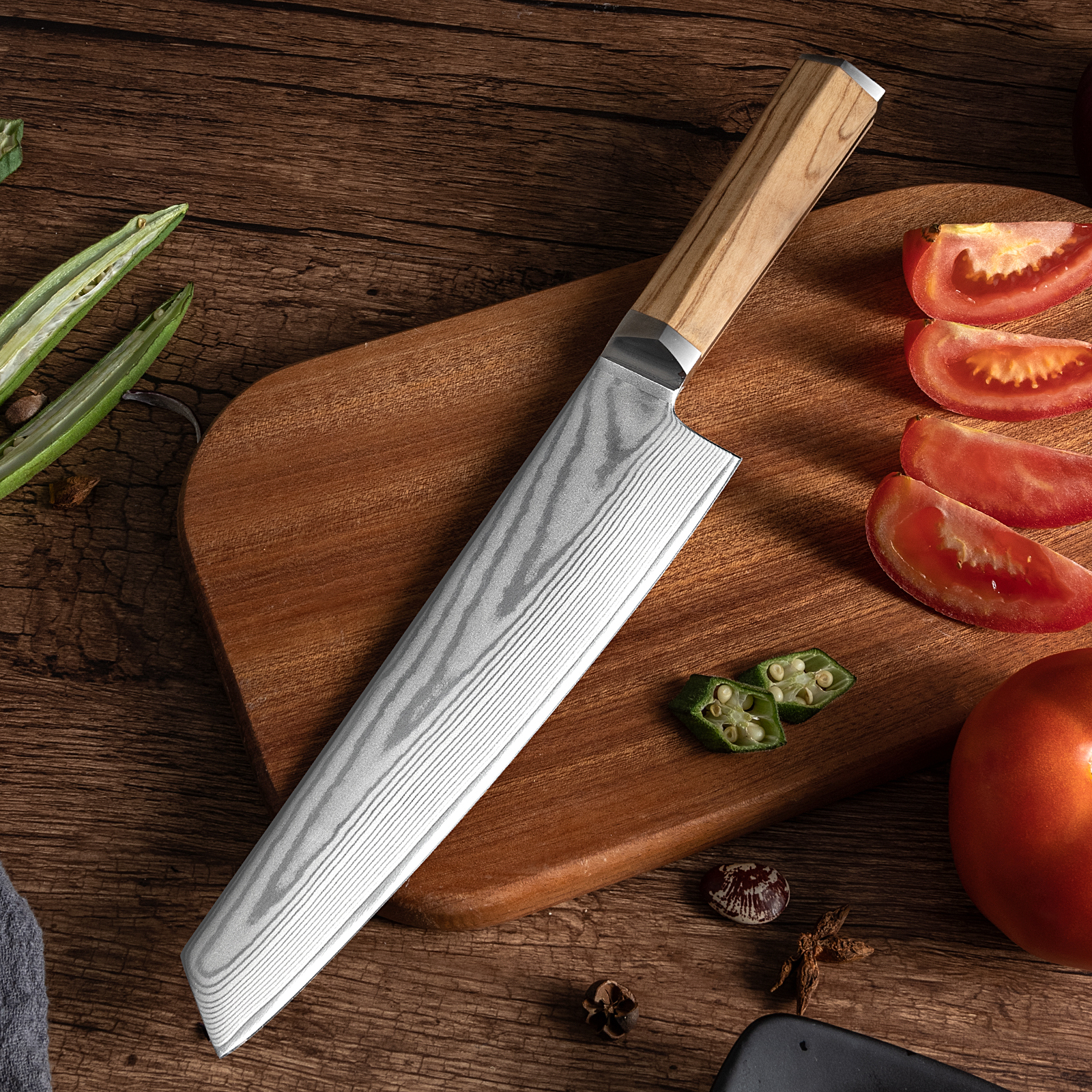Types of Japanese Knives
Apr 13,2023 | Fzkaly
Curious why Japanese knives are sought after by chefs and passionate cooks around the world? Japan’s long-standing tradition of crafting high-quality blades is not limited to katanas. It also produces the world’s best kitchen knives and is renowned for its outstanding artisanal craftsmanship and task-specific designs. Traditional Japanese knife types are so complex that to avoid confusion, we decided to only introduce the types of Japanese knives that are still commonly used nowadays. We'll offer a simple guide on the most common knife types and their specific uses. After the end of the article, we hope you’ll find a knife (or more) that is best suited for you!

Japanese Knife Types
Santoku Knife and Its Uses
Santoku, which literally means ‘three virtues’ in Japanese, stands for the knife’s 3 abilities to cut fish, meat, and vegetables. Usually, Santoku has a double-beveled blade and ranges from 165-180mm in length.
Santoku is as versatile as the Gyuto knife and chef’s knife. Compared with Gyuto, Santoku has a flatter 'belly' which is good for an up and down chopping motion rather than a 'rocking’ type cut, and it is shorter in length for more flexible control, making it excellent for chopping and long cutting strokes. That's why most Japanese families prefer the Santoku knife rather than Deba and Usuba nowadays.
Gyuto Knife and Its Uses
What Gyuto knife in Japan is what a chef's knife in Western countries. Compared with a Western-style knife, Gyuto typically has a lighter and thinner blade and is crafted out of harder steel that holds a better edge.
Gyuto also called "a cow sword", was originally to cut and break down beef. The most frequent size of Gyuto is between 210-270mm long. It features a tall heel, curved blade, and pointed tip. The impressively sharp tip is ideal for piercing and rocking motions and allows extremely precision cutting. Of course, they’re also great for chopping, slicing, and mincing basically anything. It is multifunctional too.
Nakiri / Vegetable Knife and Its Uses
Nakiri knives are equivalent to single-beveled Japanese Usuba knives, but with double-bevel.The usual length ranges from 165-180mm. The blade is thin, straight, and wide, and can't cut through animal bone, but is ideal for julienne, brunoise, allumette, and other precision knife cuts for vegetables. The best cutting way is a "push-pull" motion rather than a rocking action.
Sujihiki Knife and Its Uses
Sujihiki knives are Western-style slicers with a few differences. Made of harder steel for better edge retention and often have a thinner blade and a steeper tip for a more precise cut. Sujihiki features a long and thin blade, allowing silky glide through protein without having to saw back and forth. Thus, it can be used as a carving knife too.
Yanagi Knife and Its Use
Yanagi also called the "sashimi knife", is a traditional single-beveled Japanese knife. A single-edged blade ensures incredibly sharp cutting, meanwhile, it is dangerously sharp too. So, you should spend years learning how to use it. Typical Yanagiba knives are between 240-360mm in length.
Literally a "willow blade" due to its willow leaf-shaped blade. It has a long and slim blade and is curved at the blade tip, best suited for delicate and precise cuts. It was originally used for slicing blocks of raw fish for sashimi, Nowadays it can also be used for cutting large pieces of meat (especially for steaks).
Deba and Its Use
A heavy, classic, traditional single-edged Japanese knife for rougher tasks, Deba was originally designed for cutting and filleting fish. Fishermen and fishmongers use it to scale, behead, and filet fish without damaging the flesh. The thickness of the blade is up to 9mm making it strong enough to cut through thin or weak bones. But don't use them for thicker bones as the blade is still sensitive to chipping.
Deba knives are usually 165-210mm in length, Find the right size depending on the size of the fish or animal that is broken down.
Here are different types of Deba knives: Hon-Deba, Ko-Deba, Kanisaki-Deba, Yo-Deba, and Miroshi-Deba. Among these, Yo Deba is the most common knife. Yo-Deba is a Deba with a European handle and is more suited for cutting through bones and shellfish.
Kiritsuke Knife and Its Uses
The Kiritsuke knife is a traditional Japanese slicing knife, used for thinly slicing as either a sashimi knife or as an all-rounder knife. It is traditionally used by the executive chef only as a symbol of status in the kitchen.
Petty Knife and Its Uses
The Japanese petty knife is equivalent to a mini version of the Japanese Gyuto, also referred to as a utility or paring knife.
Petty is a good tool for peeling produce, creating decorative cuts, and handling other delicate tasks, such as cutting herbs, removing cores of fruits, etc. The size of the petty ranges from 120 to 150mm.
Honesuki Knife and Its Uses
A Honesuki is a Japanese version of a boning knife. Compared with the Western version, it has a special blade-triangular shape and sharp tip making it perfect to break down poultry as well as red meat and cutting through soft joints.
Usuba Knife and Its Uses
The Usuba is a traditional Japanese vegetable knife, similar to Nakiri, but with a single bevel, thinner blade edge, and is favored for paper-thin slices and decorative cuts. Pro chefs prefer the Usuba over the Nakiri for its precision, thus expert knife users can use it. without proper training, beginners or inexperienced knife users are more likely to injure themselves, So, if you are not a pro chef, you don't need to use it in the daily kitchen.
Final Words
Most Japanese knives are designed for specific tasks and are usually used by a pro or experienced chef knife, If you are a pro chef, owning these knives can improve your efficiency, if you are just a home cook and don't cook frequently, we recommend you choose commonly used knives.

_1080x.jpeg?w=1000&h=1000)




